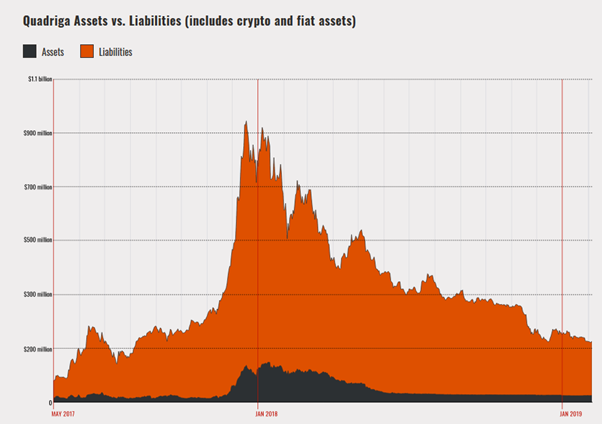Thu Dec 09 2021
QuadrigaCX
Exactly three years ago, on December 9, 2018 the Canadian Bitcoin entrepreneur Gerald Cotten was pronounced death inJaipur, India [1]. What first appeared to be a tragic complication of Crone’s disease, soon unfolded to be one of the biggest scams in history. The peculiar timing of the event led many people to believe that Cotton faked his death, only to start a new life with the over 1.85 billion dollars worth of crypto that he stole (and bought with stolen funds) from his clients at QuadrigaCX, a seemingly legitimate marketplace for buying and selling crypto. This is a story on how to steal money from 75,000 people [3] and how to get away with it.
This article points out:
- How a Ponzi scheme works and how it tries to achieve a fake legitimacy
- Fraudsters exploit basic emotions like Fear Of Missing Out
- New technology and the hype around it can easily be misused to deceive gullible people
QuadrigaCX was a Canadian bitcoin exchange founded by Gerald Cotten. After his alleged death in 2018, the company turned out to be a Ponzi scheme.
A lot of speculations circulate on whether Cotton really died. This explains why even three years after the facts, people keep on digging for answers. Following the success of the podcasting series Exit Scam [4] Netflix announced a true crime series based on the story [5]. In contrast to the uncertainty around his alleged death, it became crystal clear that Cotten secretly ran one of the most successful Ponzi schemes in history. So, what happened exactly?
The exchange
If you would surf in August 2018 to QuadrigaCX, you may well have been tempted to buy some bitcoin on the platform. After all, it was Canada’s largest crypto exchange [6]. They even had filed for an IPO years earlier. However, unhappy with the way the company was going, Gerald Cotton – co-founder and CEO- fired every single employee and remained as the only employee. A company handling millions of dollars every day being run by one person from his laptop doesn’t sound as the most solid way to manage a business. And while it wasn’t, the public didn’t quite notice. Sure, some dissatisfied customers complained about the sometimes-strange practices of the company and delays, but after all, what company doesn’t get negative feedback from time to time? But don’t be fooled by the summer of 2018, Cotten was already neck deep in his carefully built up secret scam.

Up to this day, it is a matter of debate if the Canadian entrepreneur started the company as a scam right away, or grew into it later, maybe dissatisfied with how hard it was to comply with regulations. A third possibility is that scamming was just in his DNA. As later investigation found out, he, as well as his co-founder Michael Patryn (whose real name was Omar Dhanani)- had a long track record of running online scams. More on that further on in this article. But even in the early days, the company made some shady deals with Panamanian middlemen to set up anonymous offshore bank accounts, effectively to launder money and escaping the strict Canadian legislation regarding crypto.

Whatever the answer may be, around December 2015, Cotton definitively turned a corner. He created a fake account on his own service, under the fictional name Chris Markay. Since he oversaw the backend of Quadriga, he could easily just credit the newly created account with 1 million imaginary dollars. Fake money that he then used to buy real crypto with from his unwitting customers. It started with 1700 Bitcoin (now worth $33,777,071.33).Later on he added 370,000 Ethereum, at the time worth around $4 million. That stash of Ethereum is now worth close to 2 billion dollars ($489,612,280.01) He later added even more fake dollars to his account, bought more crypto at the expense of his clients and sold them on other, legitimate crypto exchanges for real dollars. Nobody noticed, since he used an old school trick from the Ponzi-scheme handbook [9].By assuring that enough funds from new customers were held aside to pay out withdrawals, the website retained its legitimacy. However, after a while funds were not sufficient anymore to cover all the withdrawal requests, and this is when customers began experiencing long delays and shady excuses to why they couldn’t immediately get their money back. Since all this happened in the wild west of the crypto world, there were no regulations or authorities monitoring these practices. The immaturity of the technology formed a great opportunity for the fraudster. And of course, it sometimes seemed a bit fishy, but everything was new and exciting, and people were willing to take some risks, driven by FOMO (Fear Of Missing Out) induced by media stories of early bitcoin millionaires.
At the peak of the first crypto boom, more funds than ever flooded the exchange, which gave its shady operator the opportunity to steal around $100 million from customers over the course of a few weeks. The Ontario Securities Commission identified 95% of all trading volume at that time involved the account of Chris Markay [7]. Inother words, Cotten was effectively trying to suck almost all of the resources from his clients.

Graph of Quadriga’s Assets vs Liabilities, source [7]
But then it all came down. With the fall of CryptoCorp, a shady organization laundering money using Panama bank accounts for Quadriga and other questionable crypto companies, the value of bitcoin tumbled down. Since Quadriga’s funds were frozen because of the investigation, the exchange could no longer keep up with deposits. Cotten knew that his scheme would then soon be discovered. It is then plausible that he started thinking of how to run away with the money without getting caught.
In the middle of 2018, Quadriga was set up to use the incoming funds of new customers directly to pay the sellers, to stay under the radar as long as possible. But people are getting frustrated. The company tries to mitigate the extent of these problems by stating that this is because to Canada’s regulations. Despite the chaos, Cotten then decides to go on honeymoon with his fiancée to Jaipur, India. It is on this trip that Cotton allegedly dies from a cardiac arrest, caused by complications of Crone’s disease. Because of the peculiar timing of the events, and since this particular region is known to be one of the easiest places on earth to buy a fake death certificate, right from the start people started questioning if it really happened. While it is confirmed that Cotten suffered from Crone’s disease, such deadly complications are rather exceptional. Another rather murky element adds to the story: only a few weeks earlier, a will was made and signed in which Cotten leaved all his belongings to his wife. Except for a small part, that went to their dogs. Nothing was said about the business. Did the QuadrigaCX founder really die? To this day, the official answer is still “yes”. However, many people will only believe the story when the body is exhumed. The fact that Canadian authorities are not willing to do this led to a whole new batch of conspiracy theories, stating that maybe Cotten was under witness protection.
The aftermath
For a month after his alleged death, Quadriga kept running like nothing happened. Then, a small statement was released by Cotten’s widow.
Around this time, all trading on the platform was halted. Of course, people wanted their money back, but there was a big problem: all the funds of the company were held in a couple of crypto wallets, to which only Gerald Cotten had the keys to open them. Eventually, an investigation into the matter was started by the consultancy firm Ernst & Young (EY). While they didn’t find the keys for the wallets, they found out something far more chocking: the wallets were completely empty. Everything was taken out already in April 2018. 25,600Bitcoin, 11,000 Bitcoin Cash, 11,000 Bitcoin SV, 35,000 Bitcoin Gold and430,000 Ethereum, now summing up to a total value of 1,080,210,070.07 dollars were missing. Then the entire façade collapsed. Eventually, $46 million of assets were recovered, leaving a $169 million shortfall of the initial money lost by Quadriga clients [7].

The investigation
The investigations dug up more dirt. The seemingly caring and charismatic nerd appeared to have been living a shadow life for years. If you ask people that knew him during his college years, they all say that there was one strange thing about Cotton: he had money. And a lot of it. Nobody knew where it came from. As the investigation later found out, he had already run two other, much smaller but successful, Ponzi schemes in the past. He was an active member on the internet forum BlackHatWorld, under the name Murdoch1337. Peculiarly, the account has been online for the last time on August 23, 2019, almost a year after the alleged death. However, this could be explained by investigators logging in to the account. It was in this circuit- on the Ponzi forum TalkGold- that he met with his soon-to-be co-founder Michael Patryn. Note that he was born as Omar Dhanani, but changed the name twice after being convicted for laundering and his involvement with the hacking group Shadowcrew. Amy Castor, an independent reporter focused on cryptocurrencies and financial fraud made a chronological overview of the back story [10]:
- Cotten likely began promoting Ponzi schemes in his teens.
- Cotten was posting on TalkGold under the username Sceptre.
- At the same time, Patryn, known as Omar Dhanani before he changed his name, posted on TalkGold as “Patryn.”
- Patryn and Sceptre joined TalkGold in 2003, within months of each other.
- Patryn also posted as Patryn on MoneyMakerGroup and BlackHatWorld.
- Sceptre first appeared on BlackHatWorld in 2012, but then changed his profile name to Murdoch1337.
- Sceptre posted as Lucky-Invest on TalkGold to promote a Ponzi.

Lessons learned
A Ponzi scheme is arguably the most common type of scam. Since it comes in different configurations, it is not always easy to recognize one. Red flags are:
· Shady business practices, not being able to withdraw money
· Investment schemes promising guaranteed returns
· Firms operating in unregulated markets
How to protect yourself? Do your own due diligence. Websites like https://www.trustpilot.com and Reddit are very useful for this purpose.
In upcoming articles, I will further elaborate on how to assess whether a service is legit, and how to protect yourself from Ponzi schemes and other scams.
And, in general, keep in mind the golden rule: “if something seems too good to be true, then it probably is.”
More on QuadrigaCX
Excellent podcast : https://www.exitscam.show/
In-depth research : https://amycastor.com/
Netflix series (tbo) : https://www.imdb.com/title/tt15479902/
Sources
[1] Khatri, Y., & Higgins, S. (2019, February 5). Government Death Certificate Says QuadrigaCX CEO Died in India. CoinDesk. Retrieved December 2, 2021, from https://www.coindesk.com/markets/2019/02/05/government-death-certificate-says-quadrigacx-ceo-died-in-india/
[2] https://www.youtube.com/watch?v=NMDZcbkgpJA
[3] Rich, N. (2019, November 22). The Secret Life and Strange Death of Quadriga Founder Gerald Cotten. Vanity Fair. Retrieved November30, 2021, from https://www.vanityfair.com/news/2019/11/the-strange-tale-of-quadriga-gerald-cotten
[4] https://www.exitscam.show/
[5] Trust No One: The Hunt for the Crypto King (2022).(n.d.). IMDb. Retrieved November 30, 2021, from https://www.imdb.com/title/tt15479902/
[6] Murphy, B. J. (2019, February 17). Quadriga: The cryptocurrency exchange that lost $135m. BBC News. Retrieved November 30,2021, from https://www.bbc.com/news/world-us-canada-47203706
[7] Ontario Securities Commission. (n.d.). Quadriga’s Launch and Platform Operations. QuadrigaCX Report. Retrieved December 1, 2021,from https://www.osc.gov.on.ca/quadrigacxreport/quadriga-launch-continued.html#how-it-worked
[8] Rich, N. (2019b, November 22). The Secret Life and Strange Death of Quadriga Founder Gerald Cotten. Vanity Fair. Retrieved December 2,2021, from https://www.vanityfair.com/news/2019/11/the-strange-tale-of-quadriga-gerald-cotten
[9] De, N. (2020, June11). Quadriga Was a Ponzi Scheme, Ontario Securities Regulator Says. CoinDesk. Retrieved December 2, 2021, from https://www.coindesk.com/markets/2020/06/11/quadriga-was-a-ponzi-scheme-ontario-securities-regulator-says/
[10] Castor, A. (2019, June 21). Michael Patryn –. AmyCastor. Retrieved December 2, 2021, from https://amycastor.com/tag/michael-patryn/
[11] https://web.archive.org/web/20180805054219/https://www.quadrigacx.com/?ref=ar3egvj8bcpx1gg90oq5wu02


